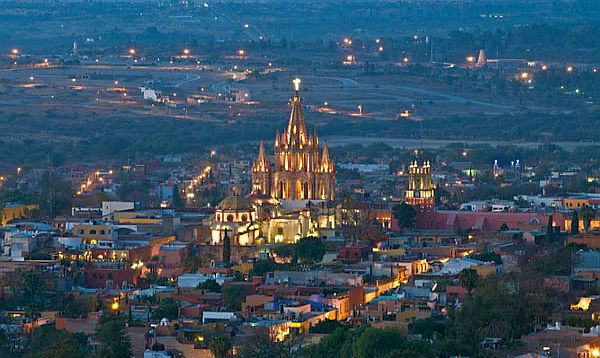La Paz, BCS, Mexico - San Miguel de Allende (SMA) is located in the eastern part of the state of Guanajuato. It is 60 miles from the state capital. Steeped in heritage, it is a region that played a major role during the Mexican revolution.
It is important for being the birthplace of Ignacio Allende, whose surname was added to the town's name in 1826. It was the first municipality declared independent of Spanish rule, by the nascent insurgent army during the Mexican War of Independence.
By the mid 18th century the city reached its height. Many large mansions, palaces and religious buildings were constructed. Most of them remain. The town was also home to the area's wealthy hacienda owners. At that time, it was one of the most important and prosperous settlements in New Spain. Its population reached 30,000. (In comparison at that time Boston had a population of only 16,000 and New York 25,000.)
 |
Since then, the city has attracted a very large number of foreign retirees, artists, writers and tourists. The area's economy is shifting from agriculture and industry to commerce that caters to outside visitors and the residents. Today SMA has a population of 165,000 with its residents representing 63 nationalities.
The main attraction is the well-preserved historic center filled with splendid architecture from the 17th and 18th centuries. San Miguel and the nearby Sanctuary of Atotonilco have been declared World Heritage Sites by the United Nations.
With this background it is easy to see why SMA was the ideal location for The Mexican Association of Real estate Professionals (AMPI) to stage its Fourth Symposium of Historic Centers and World Heritage Cities.
More than 200 AMPI members attended the event. They came from places as far away as Culiacan, La Paz, Monterrey and Veracruz.
The Symposium took place over two days. Day one featured two workshops. The first was "Raising Awareness of the Heritage in Historic Centers under Sustainable Development" The second was "Analysis and Considerations Necessary to Evaluate Historic Properties."
Day two was a series of presentations from speakers who came from Canada, Europe Latin America and Mexico. Most were architects, but a couple have post graduate degrees in Urban Planning an Administration. All have experience in successfully coordinating/ supervising projects related to preserving and managing historical city centers. Rather than detail all of the presentations, I would like to mention three and comment on a fourth.
Irma Angelica Rivera outlined how the city of Leon in Guanajuato had revitalized its city center. It's easy to see how this work could be a model in revitalizing other Mexican cities.
Doctor Claudia Fadul Rosa outlined how the city of Cartagena Columbia dealt with growth and mobility in her city. She explained how a tunnel was built under the bay in order to help alleviate traffic problems without demolishing historical buildings.
Esteban Prieto explained the history of Santo Domingo in the Dominican Republic. It is now the largest city by population in the Caribbean with a population approaching 3 million. Esteban outlined steps taken by the city government to preserve its character. He made an interesting comment. "Those of you in North America speak of developments that were started doting the sixteenth century while we speak of the fifteenth century."
 |
During its glory days, Minera de Pozos boasted 17 gold and silver haciendas and up to one thousand men working at the mines each day. "Pozos" became one of the cities where more silver was produce than anywhere else in Mexico - and perhaps anywhere else in the world.
By the early twentieth century it became a very prosperous city with 50,000 inhabitants and a strong trading network As the mines became depleted the town slowly faded until the last mine was closed in 1950.
Many call Minera de Pozos, Guanajuato a "ghost town." But that is because they have not visited it during the Mariachi Festival, which in April dresses up its quiet, cobbled streets.
Actually, this Magic Town wakes up from a short break to brighten up its streets with the "Son de la Negra" song, as well as with a good dose of international rhythms: like the Blues Festival that's held every June, or with the beat of the huehuetl, or pre-Hispanic drum, at the Toltequidad Festival in July.
Major changes are in the works for Pozo. As infrastructure is being updated and expanded, the region has opened a real estate sales office. A new larger community is being planned, including ranchettes and a hacienda.



